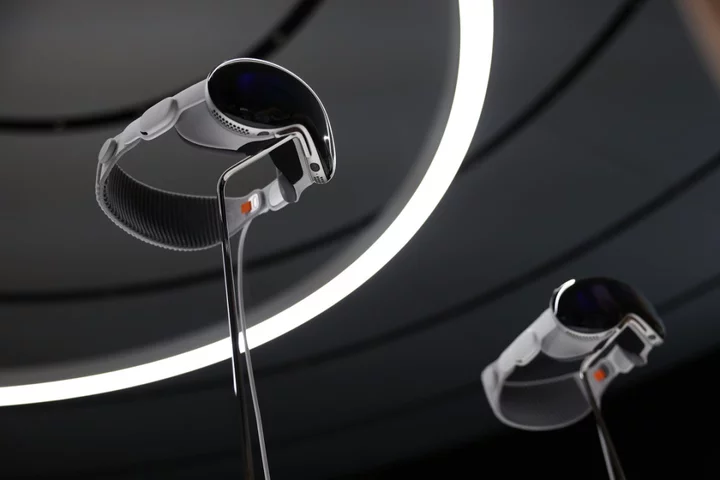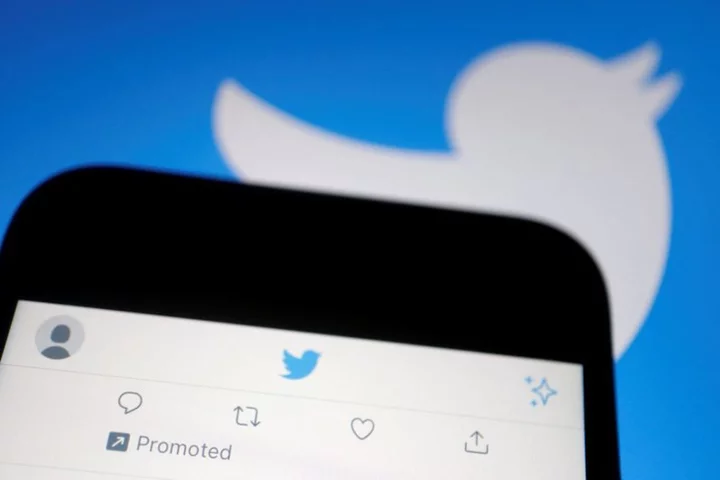Apple results show sales falling – but its big bet on services continues to pay off
Apple’s sales have fallen, and will continue to fall, the company warned in its latest results. But the company’s long-term investment in services – such as its streaming TV and music platforms and other monthly subscriptions – helped offset the fall in the number of people buying products such as iPhones and iPads. Apple shares dropped about 2% after the company predicted what could be the fourth quarter in a row of declining sales. For the just-ended period, strength in services drove the profit beat, but weaker than expected sales of Apple‘s most famous device, the iPhone, underwhelmed investors. Executives said iPhone sales would improve in the fourth quarter, but did not say how much. Apple is in a delicate position, with its entrenched iPhone battling for share against Android rivals in a mature market, while its next big product - the Vision Pro mixed-reality headset announced in June - is not yet in the hands of consumers. Apple said sales for the fiscal third quarter ended July 1 fell 1.4% to $81.8 billion and earnings per share rose 5% to $1.26. That topped analyst expectations of $81.69 billion and $1.19 per share, according to IBES data from Refinitiv. Weaker iPhone sales were balanced by strong sales in the services segment that contains Apple TV+ and by sales in China that grew 8% year over year. Apple Chief Financial Officer Luca Maestri said the company expects a year-over-year revenue performance in the company’s fiscal fourth quarter ending in September similar to the drop the company reported on Thursday. That sales forecast is below analyst expectations of roughly flat fiscal fourth-quarter sales of $90.19 billion, according to Refinitiv data. “There is a real concern about when volume picks up and what the horizon is for iPhone sales growth,” said Daniel Newman, chief executive and principal analyst at research firm Futurum Group. Apple pegged the gross profit margin in the September quarter at 44% to 45%, above analyst expectations of 43.4%, according to Refinitiv data. While Appleexpects growth in its service segment that contains Apple TV+, iPad and Mac sales will fall by “double digits,” Maestri said on the call. Apple‘s research and development spending also hit $22.61 billion for the fiscal year so far, about $3.12 billion higher than at this point in the previous year. Apple Chief Executive Officer Tim Cook told Reuters in an interview that the increased R&D spending was in part driven by work on generative artificial intelligence, the same field that is driving spending at other big technology companies. “We’ve been doing research across a wide range of AI technologies, including generative AI, for years. We’re going to continue investing and innovating and responsibly advancing our products with these technologies to help enrich people’s lives,” Cook said. “Obviously, we’re investing a lot, and it is showing up in the R&D spending that you’re looking at.” In the meantime, Apple appeared to outperform what has been the weakest smartphone market in China in almost a decade. Overall smartphone sales declined 8% in China in the calendar second quarter to their lowest levels since 2014, according to Counterpoint Research. By contrast, Cook told Reuters that Apple‘s iPhone sales in China grew by “double digits” and that sales were also high in other segments in China. That helped Apple push sales in its greater China region to $15.76 billion, from $14.60 billion in last year’s same quarter. “This was really done by attracting a quarterly record of switchers to the iPhone, as well as having a strong upgrader activity,” Cook said. “We also set quarterly records in China for both wearables, home and accessories, and services.” Apple said iPhone sales were $39.67 billion, below analyst expectations of $39.91 billion, according to Refinitiv data. Cook said the installed base of iPhones hit a new high but gave no numbers. “The company continues to face headwinds caused by waning growth in the smartphone market,” said Insider Intelligence analyst Jeremy Goldman. “All eyes are now on its earnings call for any potential Vision Pro or AI-related announcements that could further push the boundaries of their business model.” Apple‘s services segment, which includes its Apple TV+ service which has announced a deal to carry Major League Soccer, had $21.21 billion in revenue, compared with analyst estimates of $20.76 billion, according to Refinitiv data. Cook said Apple now has 1 billion subscribers on its platform, which includes both Apple services and third-party apps, up from 975 million a quarter ago. The company’s wearables business, which includes the Apple Watch and AirPods, had revenue of $8.28 billion, compared with analyst estimates of $8.39 billion, according to Refinitiv data. Mac and iPad sales were $6.84 billion and $5.79 billion, respectively, compared with analyst estimates of $6.62 billion and $6.41 billion, according to Refinitiv data. “Almost half of the Mac buyers during the quarter were new to the product, and we continue to see strong upgrader activity to Apple Silicon,” Cook told Reuters. Additional reporting by Reuters Read More Apple planning new version of AirTags – but not for some time The iPhone 15 is going to help Apple achieve one very big dream New iPhone might have a mysterious button on its side – and this is what it could do iPhone users urged to check their photo library amid fears they could be deleted Rumours are growing about some bad iPhone news Meta’s Twitter rival Threads sees ‘steep drop in daily users by 80 per cent’
Apple’s sales have fallen, and will continue to fall, the company warned in its latest results.
But the company’s long-term investment in services – such as its streaming TV and music platforms and other monthly subscriptions – helped offset the fall in the number of people buying products such as iPhones and iPads.
Apple shares dropped about 2% after the company predicted what could be the fourth quarter in a row of declining sales. For the just-ended period, strength in services drove the profit beat, but weaker than expected sales of Apple‘s most famous device, the iPhone, underwhelmed investors. Executives said iPhone sales would improve in the fourth quarter, but did not say how much.
Apple is in a delicate position, with its entrenched iPhone battling for share against Android rivals in a mature market, while its next big product - the Vision Pro mixed-reality headset announced in June - is not yet in the hands of consumers.
Apple said sales for the fiscal third quarter ended July 1 fell 1.4% to $81.8 billion and earnings per share rose 5% to $1.26. That topped analyst expectations of $81.69 billion and $1.19 per share, according to IBES data from Refinitiv. Weaker iPhone sales were balanced by strong sales in the services segment that contains Apple TV+ and by sales in China that grew 8% year over year.
Apple Chief Financial Officer Luca Maestri said the company expects a year-over-year revenue performance in the company’s fiscal fourth quarter ending in September similar to the drop the company reported on Thursday. That sales forecast is below analyst expectations of roughly flat fiscal fourth-quarter sales of $90.19 billion, according to Refinitiv data.
“There is a real concern about when volume picks up and what the horizon is for iPhone sales growth,” said Daniel Newman, chief executive and principal analyst at research firm Futurum Group.
Apple pegged the gross profit margin in the September quarter at 44% to 45%, above analyst expectations of 43.4%, according to Refinitiv data. While Appleexpects growth in its service segment that contains Apple TV+, iPad and Mac sales will fall by “double digits,” Maestri said on the call.
Apple‘s research and development spending also hit $22.61 billion for the fiscal year so far, about $3.12 billion higher than at this point in the previous year.
Apple Chief Executive Officer Tim Cook told Reuters in an interview that the increased R&D spending was in part driven by work on generative artificial intelligence, the same field that is driving spending at other big technology companies.
“We’ve been doing research across a wide range of AI technologies, including generative AI, for years. We’re going to continue investing and innovating and responsibly advancing our products with these technologies to help enrich people’s lives,” Cook said. “Obviously, we’re investing a lot, and it is showing up in the R&D spending that you’re looking at.”
In the meantime, Apple appeared to outperform what has been the weakest smartphone market in China in almost a decade. Overall smartphone sales declined 8% in China in the calendar second quarter to their lowest levels since 2014, according to Counterpoint Research. By contrast, Cook told Reuters that Apple‘s iPhone sales in China grew by “double digits” and that sales were also high in other segments in China.
That helped Apple push sales in its greater China region to $15.76 billion, from $14.60 billion in last year’s same quarter.
“This was really done by attracting a quarterly record of switchers to the iPhone, as well as having a strong upgrader activity,” Cook said. “We also set quarterly records in China for both wearables, home and accessories, and services.”
Apple said iPhone sales were $39.67 billion, below analyst expectations of $39.91 billion, according to Refinitiv data. Cook said the installed base of iPhones hit a new high but gave no numbers.
“The company continues to face headwinds caused by waning growth in the smartphone market,” said Insider Intelligence analyst Jeremy Goldman. “All eyes are now on its earnings call for any potential Vision Pro or AI-related announcements that could further push the boundaries of their business model.”
Apple‘s services segment, which includes its Apple TV+ service which has announced a deal to carry Major League Soccer, had $21.21 billion in revenue, compared with analyst estimates of $20.76 billion, according to Refinitiv data.
Cook said Apple now has 1 billion subscribers on its platform, which includes both Apple services and third-party apps, up from 975 million a quarter ago.
The company’s wearables business, which includes the Apple Watch and AirPods, had revenue of $8.28 billion, compared with analyst estimates of $8.39 billion, according to Refinitiv data.
Mac and iPad sales were $6.84 billion and $5.79 billion, respectively, compared with analyst estimates of $6.62 billion and $6.41 billion, according to Refinitiv data. “Almost half of the Mac buyers during the quarter were new to the product, and we continue to see strong upgrader activity to Apple Silicon,” Cook told Reuters.
Additional reporting by Reuters
Read More
Apple planning new version of AirTags – but not for some time
The iPhone 15 is going to help Apple achieve one very big dream
New iPhone might have a mysterious button on its side – and this is what it could do
iPhone users urged to check their photo library amid fears they could be deleted
Rumours are growing about some bad iPhone news
Meta’s Twitter rival Threads sees ‘steep drop in daily users by 80 per cent’









